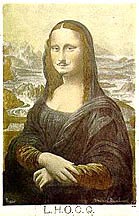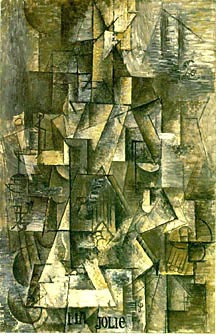

Cubism was the most radical and influential “ism” in 20th Century art. It provided the catalyst to 20th Century art that the I5th Century Italian Renaissance provided to the I6th Century Italian High Renaissance. Cubism was the joint invention of Picasso and Braque. Dedicated “ to the simplification of painting”, they (attempted) to exclude all but the formal elements of art: line, shape, and color (formalism). Inspired by Cezanne, the Cubists developed a new way of depicting space which involved multiple and mixed perspectives. Because they believed that there “was no one fixed view of nature”, the figure and ground were given equal importance and broken into geometric components or facets. Cubism lead to abstraction and necessitated a new way of looking at art. The first phase, Analytical Cubism was more intellectual than its more decorative second phase, Synthetic Cubism.
Analytical Cubism is the first developmental phase of Cubism. The work is difficult to read (interpret) and is willfully ambiguous.
![]()
Portrait of Ambrose Vollard, 1910
![]()
Portrait of Daniel-Henry Kahnweiler, 1910
![]()

Ma Jolie, 1911
![]()
Fast Facts
Collage was an outgrowth of Analytical Cubism where reality is found in the overlapping relationships of interdependent views or events. By 1912, mass production and reproduction was a part of everyday Parisian life: newspapers, printed labels, etc. The overlay of posters on walls, and modern signs created a layered cityscape that resulted in a visual change for everyone.
Influenced by what he saw around him, Picasso pasted various real-life materials not normally associated with each other, e.g. bits of paper, onto a flat surface to create an arrangement. He usually added drawn or painted marks or images.
Real-life materials were thought to better represent “reality” for making art because they are closely connected to daily life. Picasso and future artists found the collage process liberating; it suggests new and infinite possibilities of what art can be. There is a sense of compelling immediacy to collage.
Still Life with Chair-Caning, 1912
![]()
![]()
![]()
![]()
![]() Go back to the 20th Century Art
Categories
Go back to the 20th Century Art
Categories
![]() Go back to the 20th Century Art Welcome
Page
Go back to the 20th Century Art Welcome
Page
![]() Go Back to the West Valley College
Homepage
Go Back to the West Valley College
Homepage
